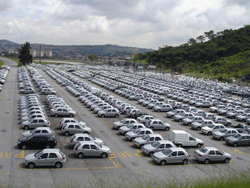Record results for Brazilian exports
 Brazilian vehicle exports grew strongly in 2013, including a rise of nearly 30% for passenger car exports, thanks in part to a weak Brazilian real.
Brazilian vehicle exports grew strongly in 2013, including a rise of nearly 30% for passenger car exports, thanks in part to a weak Brazilian real.
Data released by the National Association of Automobile Manufacturers (Anfavea) suggests that the overall value of $16.6 billion, which includes cars, light commercial vehicles, buses, trucks and agricultural machinery, such as tractors and harvesters, is a record.
For the year, a total of 563,268 fully assembled units were shipped, up 26.5% over 2012, while an additional 27,263 complete knockdown (CKD) units were also exported, an increase of 1.6%. Passenger vehicles grew 29% to 395,950 units, while agricultural exports declined by 8% to 15,600 units.
Meanwhile, domestic sales in Brazil declined 0.9% to just below 3.8m new vehicles in 2013.
Brazil also had a record year in overall vehicle production, with a combined 3.74m cars, light commercial vehicles, trucks and buses built, equivalent to growth of 9.9 % over 2012, although this figure does not include farm machinery.
For 2014, Anfavea is predicting a 2.6% growth in the value of vehicle exports, while it suggests the number of overall units built will grow by 0.7% and domestic sales increase by 1.1%.
Investment in infrastructure
More widely, the association has set a target for the sector of reaching 1m vehicle exports by 2017, more than double the current levels. However, speakers at the most recent Automotive Logistics South America conference, held in Sao Paulo last October, broadly agreed that the country’s port and inland connections would not be able to cope with such levels today.
“If Brazil were to export 1m vehicles today, the ports would face logistics chaos,” said Sérgio Tanibata, director of business at Cisa Trading, Brazil’s largest car importer.
That said, despite often chaotic infrastructure conditions following years of underinvestment, logistics experts say infrastructure is now on the government’s agenda, and there seems to be a realisation that urgent investment is required to enable productivity.
Brazil has a variety of high-profile port working groups and politicians who have tried, with varying success, to push a bill through Congress to change the rules on private investment. Meanwhile, the government is encouraging banks to finance projects that are related to infrastructure. (Read more about the country’s investment plans here).
Another factor affecting exports however relates to its neighbours. Venezuela’s closed economy has shut it off as a destination for Brazilian exports. Argentina has imposed trade restrictions that have led to delays in and out of Brazil’s ports as shipping lines are forced to reroute. This is significant for the automotive sector, since, according to ocean carrier and logistics provider Wallenius Wilhelmsen Logistics (WWL), both countries send nearly 90% of their vehicle exports to one another.
Argentina is the biggest problem for port traffic and vehicle logistics right now [in South America],” said Flavio Batista, WWL’s vice president for Latin America, also speaking at the conference in October.





